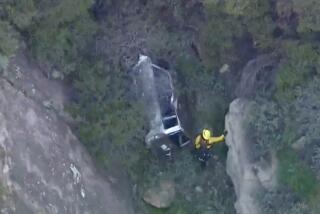Indian Excavation Starts at Park Site
- Share via
State archeologists Tuesday began an emergency excavation of a 1,000-year-old Calabasas Indian village that lies beneath the planned main entrance to Malibu Creek State Park.
Officials said they will sift through dirt taken from sample holes dug at the site of the ancient village of Talapop before deciding whether to allow construction of the $560,000 road.
Archeologists said their first spadefuls of dirt turned up bone fragments and beads. If the bones are found to be human, the road will be abandoned, officials said.
John Kelly, state Department of Parks and Recreation archeologist heading the $30,000 excavation, said a thorough evaluation of artifacts and fragments from four test holes will take up to four weeks.
He said the state Coastal Commission, which has jurisdiction over the park-entrance project, will have final authority over construction.
“But, if we find human remains here, the project is shut down,” Kelly said. “We do not disturb human Indian remains on state park property.”
Tuesday’s excavation was at the site of a planned right-turn lane from Las Virgenes Road into the park. Park officials last year built a ranger’s office, entrance gate guard building and parking lot driveway in anticipation of the new entrance to the 7,000-acre park.
Los Angeles County workers started grading the county part of the road in August. They were pouring asphalt at the site, about a quarter-mile south of Mulholland Highway, on Sept. 26 when angry Chumash Indian tribal leaders persuaded the Coastal Commission to temporarily halt work until an archeological assessment could be made.
Tribal representative Posh Moyle was at the scene Tuesday to observe the work.
“This is a testing that is crucial,” Moyle said. “If things are there, we’ll find evidence of it in these four holes.”
‘Shameful’ Effort
Two holes were dug Tuesday about 10 feet apart. The area in dispute is about 1,000 feet long and 12 feet wide.
Moyle criticized county and state efforts to build the entrance off Las Virgenes Road as “shameful.” She said a 1981 University of California archeological study of another part of the Talapop village site showed the area to be laden with artifacts.
Chester King, an archeologist familiar with the 1981 exploration, has characterized the Calabasas site as “inch-for-inch richer” in artifacts than the more publicized “Lost Village of Encino,” excavated last year.
The Calabasas Chumash village is believed to have flourished for about 900 years, until the 1830s. Its location at the southern end of the Las Virgenes Valley, near Malibu Canyon, made it an important trading center for Indians in Malibu and the San Fernando Valley, according to Indian experts.
Kelly said it is the largest intact Chumash village site in the Santa Monica Mountains.
More to Read
Sign up for Essential California
The most important California stories and recommendations in your inbox every morning.
You may occasionally receive promotional content from the Los Angeles Times.











